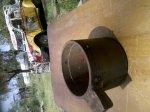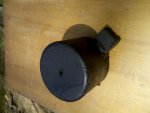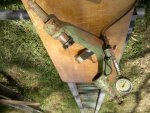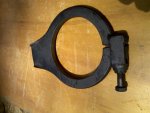at this point i offer an apology to pottsy, i have steered your inquiry a little off topic. . . Bob, post some pics of your rig or i'll be in the doghouse!
Cheers
chris
OK OK......




Accumulator tool (2 views) clamps with 6 x 8mm grub screws around rim.
I grip the other part in my 4 jaw in the lathe. the centre in the tool is held by the lathe tail stock to keep it straight while flogging the short arm. with a big hammer.
The Gas tool, accepts (almost ) all sphere types including accumulators. Head has minimum volume to reduce gas wastage. I have multiple different plug tools to operate original, slotted, smooth round (plug cap has 3 x 3mm grub screws to grip plug) etc. The rig can be mounted inverted to use gravity to locate the O-ring in spheres where O-ring movement is a problem.
It can top up with out wasting gas, as well as recharge from flat.
The Sphere tool .... again hold top in lathe 4 jaw, tool clamps on rim of sphere body, flog short arm....
Any further questions?
I did design a "Super Universal" sphere work centre, with tools attached (so you don't need a lathe as a holder), precharge check and gas rig all built in...... never got it built yet.... but should. If I make.... say 6 units at .... say $1000 each.... any takers ? (not including gas bottle or reg).


